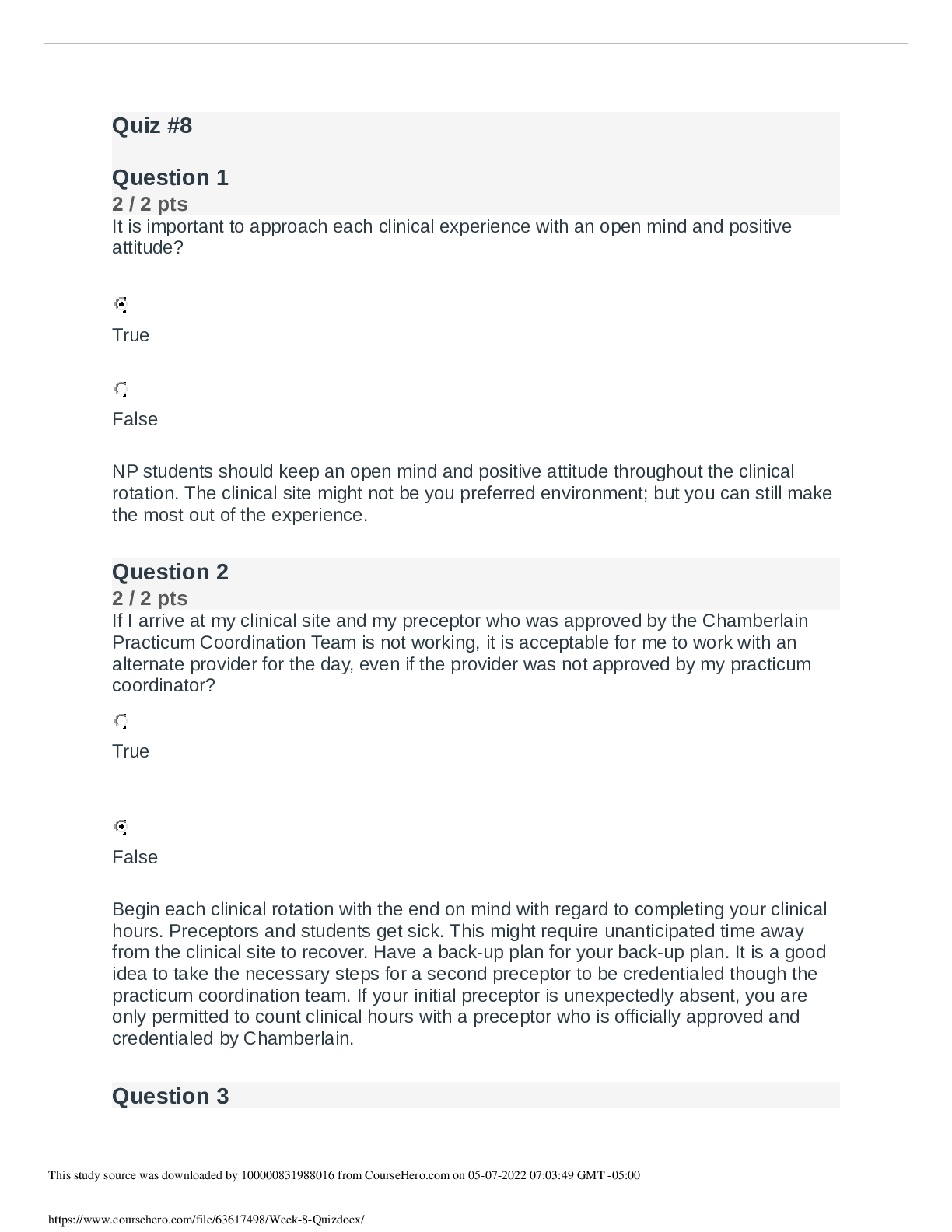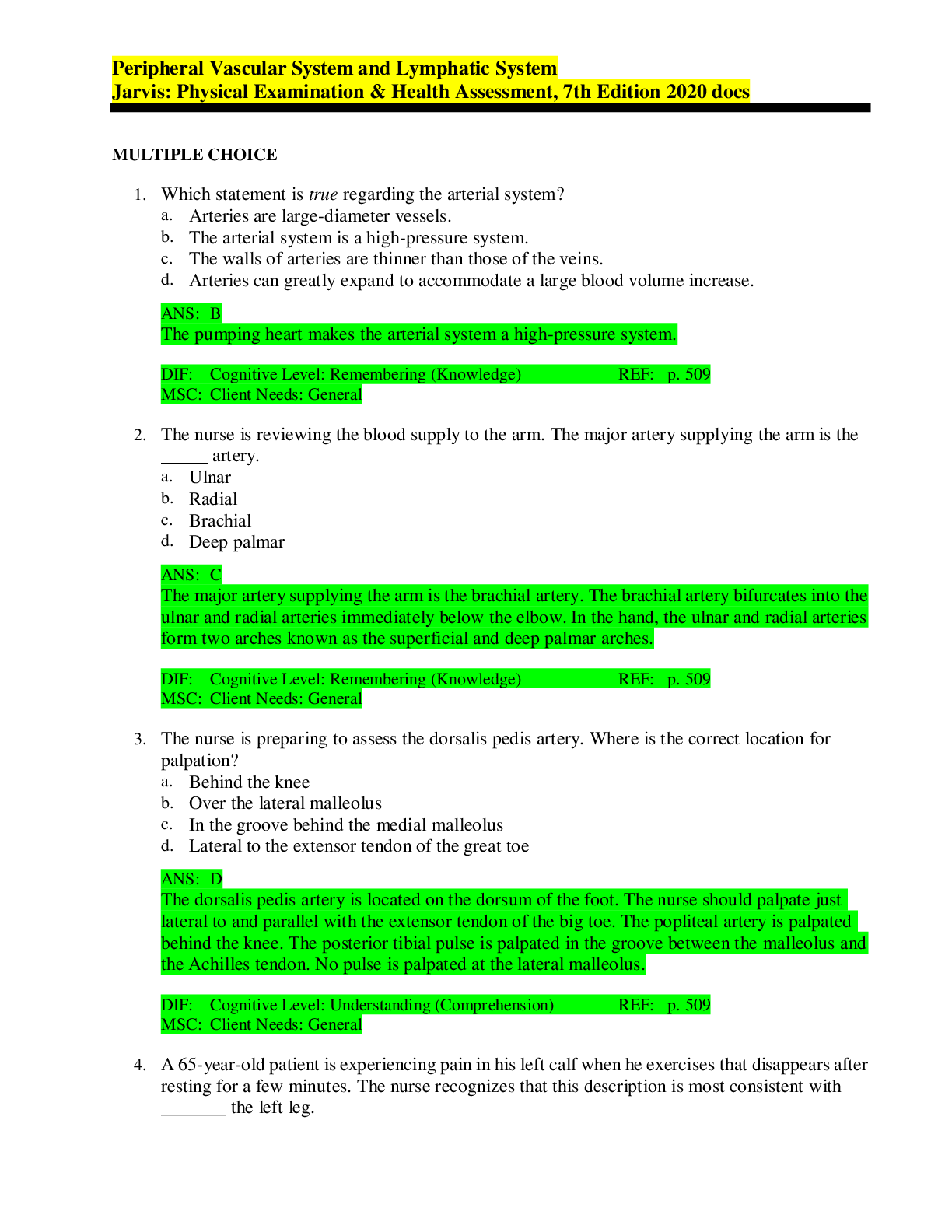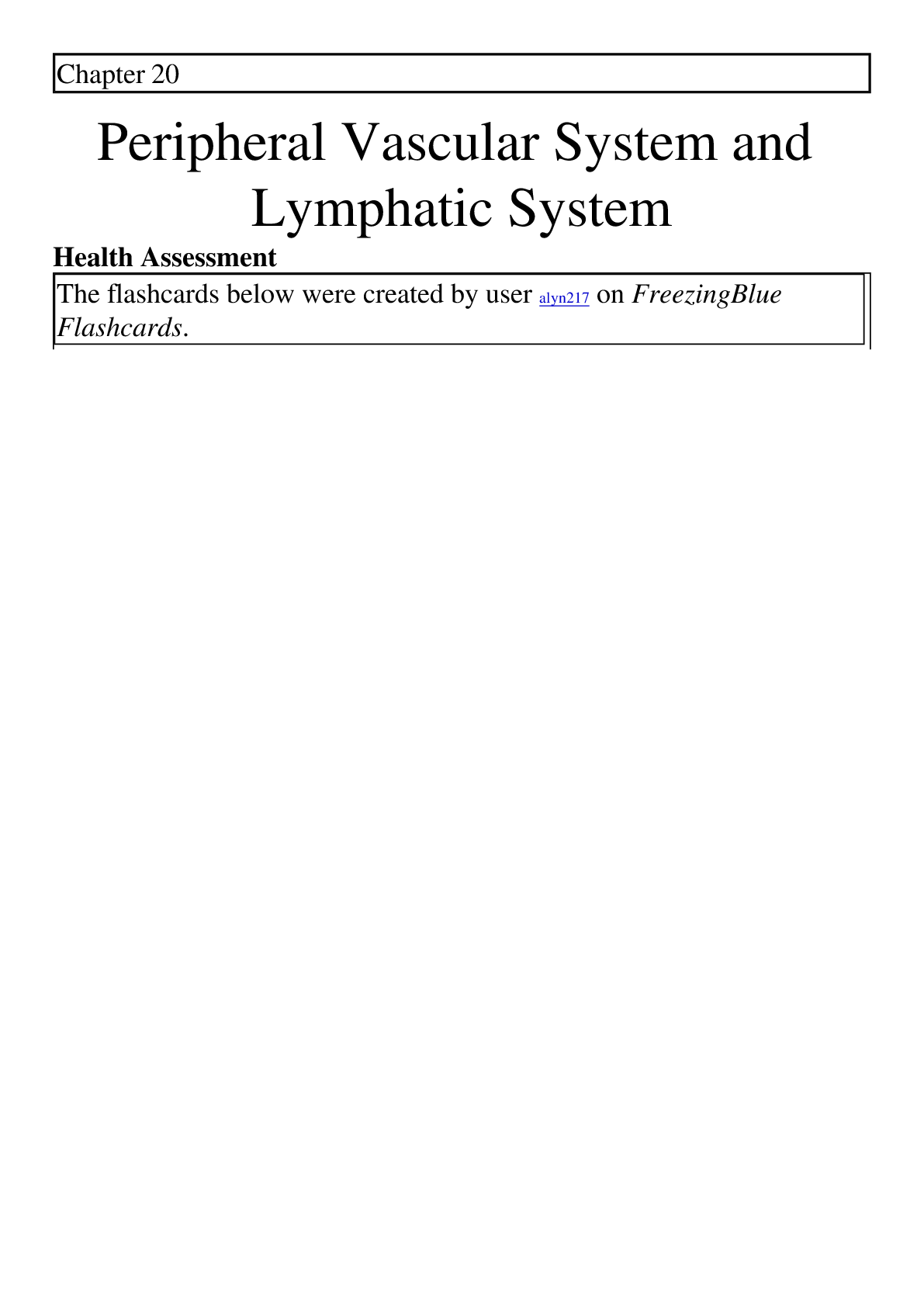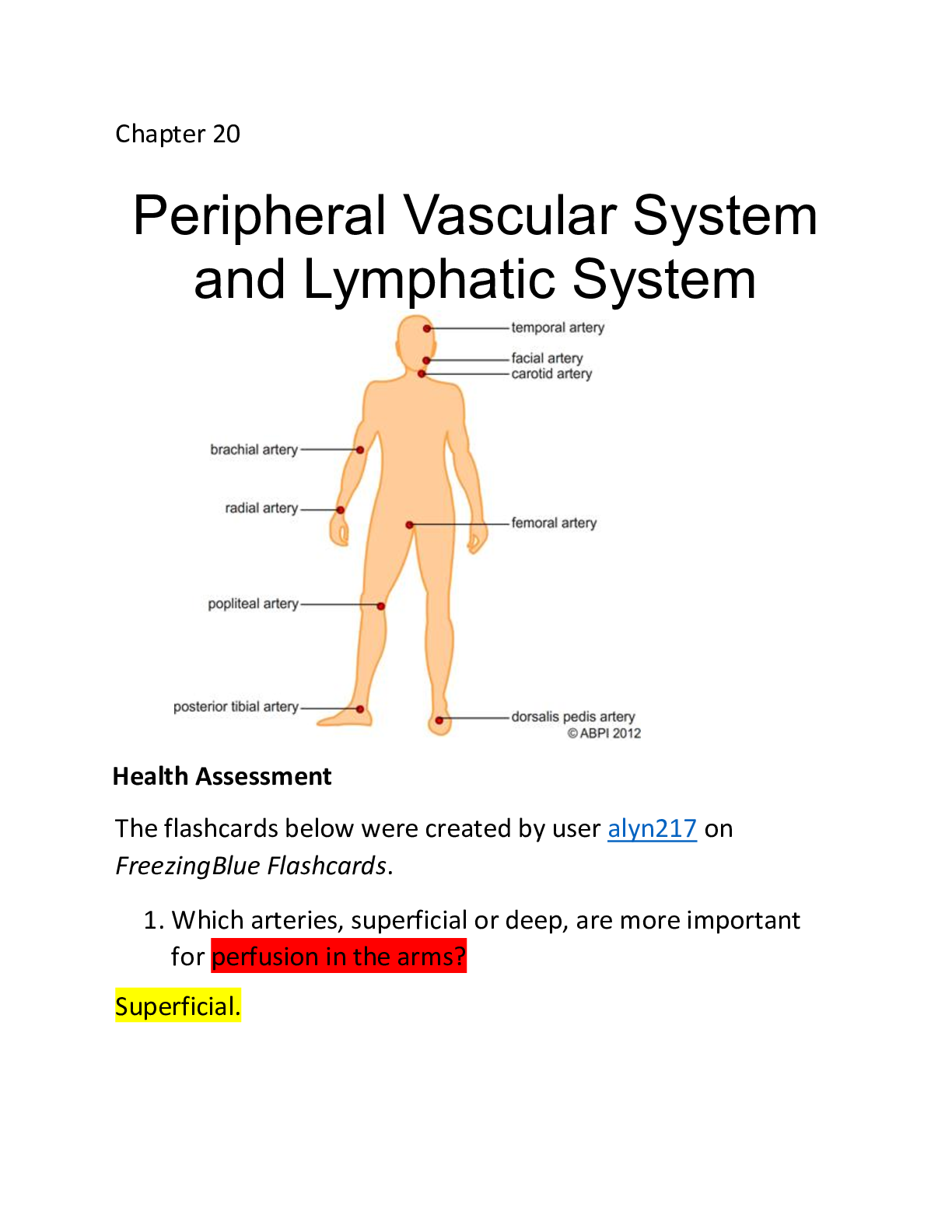*NURSING > QUESTIONS & ANSWERS > SOLVED!!! NR 509 COMPREHENSIVE REVIEW OF JARVIS 7TH EDITION CHAPTER 20 QUESTIONS (Peripheral Vascula (All)
SOLVED!!! NR 509 COMPREHENSIVE REVIEW OF JARVIS 7TH EDITION CHAPTER 20 QUESTIONS (Peripheral Vascular System and Lymphatic System: Physical Examination & Health Assessment)
Document Content and Description Below
SOLVED!!! NR 509 COMPREHENSIVE REVIEW OF JARVIS 7TH EDITION CHAPTER 20 QUESTIONS (Peripheral Vascular System and Lymphatic System: Physical Examination & Health Assessment) ◇This material contains c... omprehensive summary of information in the form of great test questions with descriptive answers helpful for exams study. Thorough Review of Jarvis 7th Edition Chapter 20 Questions. All the best Champions!!! _____ MULTIPLE CHOICE 1. Which statement is true regarding the arterial system? a. Arteries are large-diameter vessels. b. The arterial system is a high-pressure system. c. The walls of arteries are thinner than those of the veins. d. Arteries can greatly expand to accommodate a large blood volume increase. ANS: B The pumping heart makes the arterial system a high-pressure system. DIF: Cognitive Level: Remembering (Knowledge) MSC: Client Needs: General REF: p. 509 2. The nurse is reviewing the blood supply to the arm. The major artery supplying the arm is the _____ artery. a. Ulnar b. Radial c. Brachial d. Deep palmar ANS: C The major artery supplying the arm is the brachial artery. The brachial artery bifurcates into the ulnar and radial arteries immediately below the elbow. In the hand, the ulnar and radial arteries form two arches known as the superficial and deep palmar arches. DIF: Cognitive Level: Remembering (Knowledge) MSC: Client Needs: General REF: p. 509 3. The nurse is preparing to assess the dorsalis pedis artery. Where is the correct location for palpation? a. Behind the knee b. Over the lateral malleolus c. In the groove behind the medial malleolus d. Lateral to the extensor tendon of the great toe ANS: D The dorsalis pedis artery is located on the dorsum of the foot. The nurse should palpate just lateral to and parallel with the extensor tendon of the big toe. The popliteal artery is palpated behind the knee. The posterior tibial pulse is palpated in the groove between the malleolus and the Achilles tendon. No pulse is palpated at the lateral malleolus. DIF: Cognitive Level: Understanding (Comprehension) REF: p. 509MSC: Client Needs: General 4. A 65-year-old patient is experiencing pain in his left calf when he exercises that disappears after resting for a few minutes. The nurse recognizes that this description is most consistent with _______ the left leg. a. Venous obstruction of b. Claudication due to venous abnormalities in c. d. Ischemia caused by a partial blockage of an artery supplying Ischemia caused by the complete blockage of an artery supplying ANS: C Ischemia is a deficient supply of oxygenated arterial blood to a tissue. A partial blockage creates an insufficient supply, and the ischemia may be apparent only during exercise when oxygen needs increase. DIF: Cognitive Level: Analyzing (Analysis) REF: pp. 509-510 MSC: Client Needs: Physiologic Integrity: Physiologic Adaptation 5. The nurse is reviewing venous blood flow patterns. Which of these statements best describes the mechanism(s) by which venous blood returns to the heart? a. b. Intraluminal valves ensure unidirectional flow toward the heart. Contracting skeletal muscles milk blood distally toward the veins. c. High-pressure system of the heart helps facilitate venous return. d. Increased thoracic pressure and decreased abdominal pressure facilitate venous return to the heart. ANS: A Blood moves through the veins by (1) contracting skeletal muscles that proximally milk the blood; (2) pressure gradients caused by breathing, during which inspiration makes the thoracic pressure decrease and the abdominal pressure increase; and (3) the intraluminal valves, which ensure unidirectional flow toward the heart. DIF: Cognitive Level: Understanding (Comprehension) MSC: Client Needs: General REF: p. 511 6. Which vein(s) is(are) responsible for most of the venous return in the arm? a. Deep b. Ulnar c. Subclavian d. Superficial ANS: D The superficial veins of the arms are in the subcutaneous tissue and are responsible for most of the venous return. DIF: Cognitive Level: Remembering (Knowledge) MSC: Client Needs: General REF: p. 5107. A 70-year-old patient is scheduled for open-heart surgery. The surgeon plans to use the great saphenous vein for the coronary bypass grafts. The patient asks, “What happens to my circulation when this vein is removed?” The nurse should reply: “Venous insufficiency is a common problem after this type of surgery.” a. b. c. d. “Oh, you have lots of veins—you won’t even notice that it has been removed.” “You will probably experience decreased circulation after the vein is removed.” “This vein can be removed without harming your circulation because the deeper veins in your leg are in good condition.” ANS: D As long as the femoral and popliteal veins remain intact, the superficial veins can be excised without harming circulation. The other responses are not correct. DIF: Cognitive Level: Analyzing (Analysis) REF: p. 510 MSC: Client Needs: Physiologic Integrity: Physiologic Adaptation 8. The nurse is reviewing the risk factors for venous disease. Which of these situations best describes a person at highest risk for the development of venous disease? a. Woman in her second month of pregnancy b. Person who has been on bed rest for 4 days c. Person with a 30-year, 1 pack per day smoking habit d. Older adult taking anticoagulant medication ANS: B People who undergo prolonged standing, sitting, or bed rest are at risk for venous disease. Hypercoagulable (not anticoagulated) states and vein-wall trauma also place the person at risk for venous disease. Obesity and the late months of pregnancy are also risk factors. DIF: Cognitive Level: Applying (Application) REF: p. 512 MSC: Client Needs: Physiologic Integrity: Reduction of Risk Potential 9. The nurse is teaching a review class on the lymphatic system. A participant shows correct understanding of the material with which statement? a. b. c. d. “Lymph flow is propelled by the contraction of the heart.” “The flow of lymph is slow, compared with that of the blood.” “One of the functions of the lymph is to absorb lipids from the biliary tract.” “Lymph vessels have no valves; therefore, lymph fluid flows freely from the tissue spaces into the bloodstream.” ANS: B The flow of lymph is slow, compared with flow of the blood. Lymph flow is not propelled by the heart but rather by contracting skeletal muscles, pressure changes secondary to breathing, and contraction of the vessel walls. Lymph does not absorb lipids from the biliary tract. The vessels do have valves; therefore, flow is one way from the tissue spaces to the bloodstream. DIF: Cognitive Level: Understanding (Comprehension) REF: p. 513MSC: Client Needs: Physiologic Integrity: Physiologic Adaptation 10. When performing an assessment of a patient, the nurse notices the presence of an enlarged right epitrochlear lymph node. What should the nurse do next? a. Assess the patient’s abdomen, and notice any tenderness. b. Carefully assess the cervical lymph nodes, and check for any enlargement. c. d. Ask additional health history questions regarding any recent ear infections or sore throats. Examine the patient’s lower arm and hand, and check for the presence of infection or lesions. ANS: D The epitrochlear nodes are located in the antecubital fossa and drain the hand and lower arm. The other actions are not correct for this assessment finding. DIF: Cognitive Level: Applying (Application) REF: p. 513 MSC: Client Needs: Safe and Effective Care Environment: Management of Care 11. A 35-year-old man is seen in the clinic for an infection in his left foot. Which of these findings should the nurse expect to see during an assessment of this patient? a. Hard and fixed cervical nodes b. Enlarged and tender inguinal nodes c. Bilateral enlargement of the popliteal nodes d. Pelletlike nodes in the supraclavicular region ANS: B The inguinal nodes in the groin drain most of the lymph of the lower extremities. With local inflammation, the nodes in that area become swollen and tender. DIF: Cognitive Level: Applying (Application) REF: p. 513 MSC: Client Needs: Physiologic Integrity: Physiologic Adaptation 12. The nurse is examining the lymphatic system of a healthy 3-year-old child. Which finding should the nurse expect? a. Excessive swelling of the lymph nodes b. Presence of palpable lymph nodes c. No palpable nodes because of the immature immune system of a child d. Fewer numbers and a smaller size of lymph nodes compared with those of an adult ANS: B Lymph nodes are relatively large in children, and the superficial ones are often palpable even when the child is healthy. DIF: Cognitive Level: Applying (Application) MSC: Client Needs: Health Promotion and Maintenance REF: p. 514 [Show More]
Last updated: 1 year ago
Preview 1 out of 14 pages
.png)
Buy this document to get the full access instantly
Instant Download Access after purchase
Add to cartInstant download
We Accept:

Reviews( 0 )
$15.00
Document information
Connected school, study & course
About the document
Uploaded On
Sep 13, 2021
Number of pages
14
Written in
Additional information
This document has been written for:
Uploaded
Sep 13, 2021
Downloads
0
Views
47





.png)
.png)
.png)

.png)









.png)


